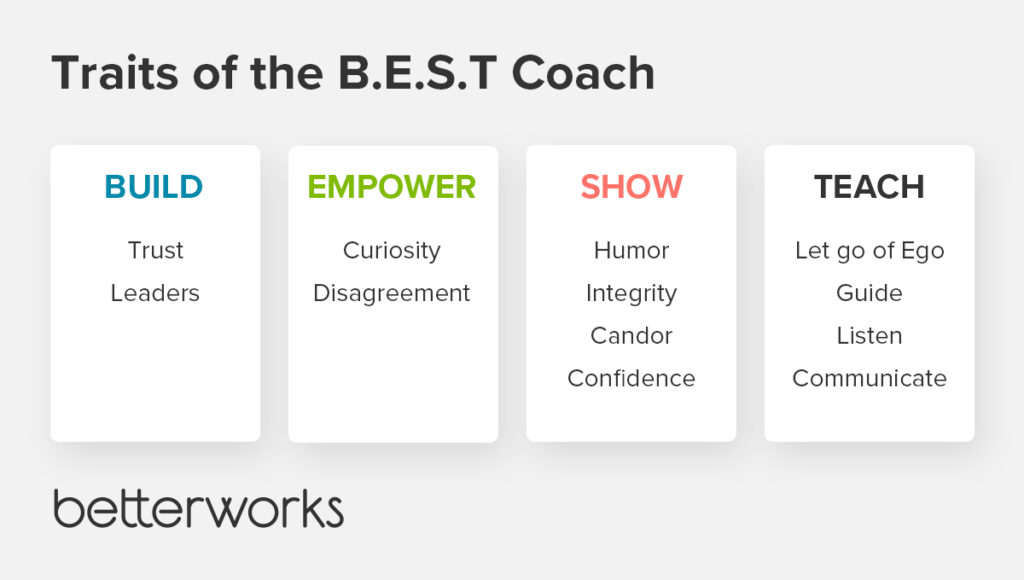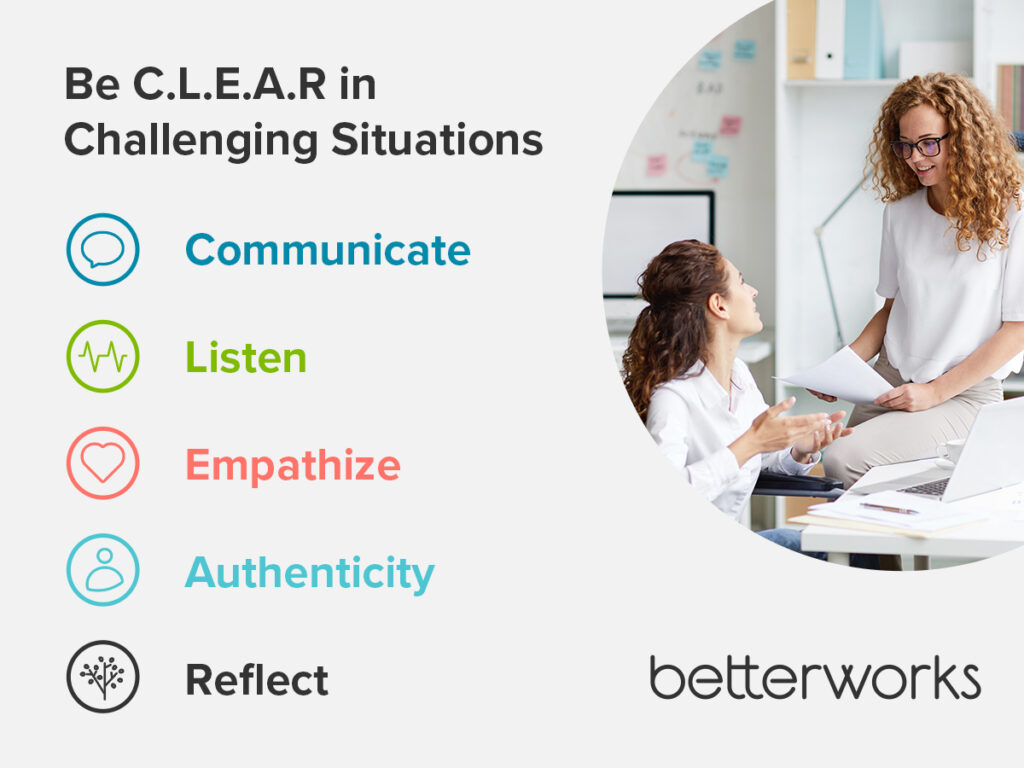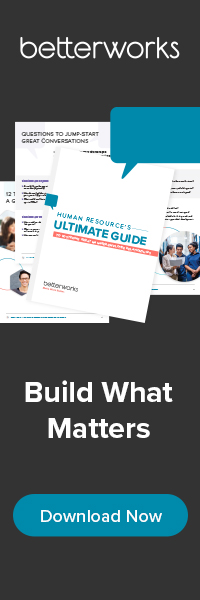- Managers are struggling and want help from HR
- Employees trust managers the most
- Build up managers as coaches with B.E.S.T.
- Offer training, mentoring, and the right tools
- Provide guidelines for successful conversations
- Teach the C.L.E.A.R. framework for challenging conversations
- Train managers to guard against bias
- Focus on connection and communication
Managers are the conduit through which employees receive vital communications, understand company values, and experience belonging, growth, a sense of purpose, and so much more. Their influence is monumental — and the manager-employee relationship is perhaps the most important one in an organization. Many of us are probably familiar with the Gallup statistic that managers account for 70% of the variance in team engagement. What can HR leaders do to assist and positively influence the manager-employee relationship?
We set out to break that down in HR’s Guide to Fostering Great Manager-Employee Relationships. It includes explanations of the 12 traits of a great “manager coach” based on Betterworks’ proprietary B.E.S.T. framework, steps HR can take to help strengthen manager competencies, and guidelines for enabling productive manager-employee conversations, which are foundational to solid relationships. We’ve also included questions managers can use to jump-start conversations and explain the types of conversations for which HR can develop templates. Finally, we’ve included steps managers can follow when they must have difficult conversations based on our C.L.E.A.R. approach, and biases managers should be aware of during communications with employees.
Before we delve into HR tips and tools for strengthening manager-employee relationships, let’s start by understanding the potential risks HR has the power to mitigate.
Managers are struggling and want help from HR
A report from UKG earlier this year found that 46% of managers said they were likely to quit because of job-related stress. Like everyone else, they are affected by accelerating change at work and economic uncertainty. But unlike individual contributors and even leaders, managers are caught in the middle — expected to deliver on the demands of the business and to guide, coach, and relate to their reports in very humanistic ways. Hybrid work environments, along with employees’ changing expectations of their employers, have altered the manager’s role.
At the same time, organizational support of key drivers of managerial effectiveness is declining. A 2023 study from Red Thread Research showed that organizational clarity on what employees need to do to succeed in the future fell 10 percentage points to 38% from 2021 to 2022. Data-based insights about team engagement declined by 7 points to 33%. According to Red Thread, this lower level of support drives employees’ view that their managers are less effective, even though employees view their manager’s behaviors as mostly unchanged year over year. Our own State of Performance Enablement research shows that managers want more help from HR, but only a quarter always get the support they need. Just under half receive some support, and about a third receive support either rarely or not at all.
The bottom line is that organizations — specifically, the people in charge — have the responsibility and ability to adopt practices that will strengthen manager effectiveness and, ultimately, the manager-employee relationship. The outcomes are well worth the effort: Red Thread’s research reveals that companies with effective managers realize a higher NPS and greater engagement.
Employees trust managers the most
Without transparency and accountability, there is no trust. And without trust, everything becomes a steep hill to climb for the employee, the manager, and the employer. Betterworks’ State of Performance Enablement report shows that while employees trust their team members the most (68%), managers are a close second at 63%. It makes sense to continue to build on this trust by strengthening the manager-employee connection.
Great conversations are a cornerstone of healthy manager-employee relationships. And our research showed satisfaction with performance and career development conversations correlated to higher engagement, productivity, and intent to stay.
To distill all this research to its essence, if HR leaders can, with the support of leadership, provide the support, resources, and tools to foster healthy manager-employee relationships, their organizations stand to reap positive outcomes — in engagement, productivity, and retention — far above the effort they put in.
Here are five actions HR leaders can take to drive a thriving workforce by focusing on the key relationship in their organization.
Build up managers as coaches with B.E.S.T.
B.E.S.T. is Betterworks’ framework for helping managers go from good to great. The acronym stands for build, empower, show, and teach.
It starts with the assumption that the optimal managerial style predominantly focuses on coaching rather than being a boss. The latter is more authoritative and task-focused. In certain situations, such as an emergency, managers who are coaches will need to adopt an authoritative stance, but generally speaking, they are relationship-focused. They see their role as empowering others — being a guide, listener, communicator, troubleshooter, resource provider, and breaker of bottlenecks.
Within the B.E.S.T. framework, there are 12 traits. Our guide covers them in greater detail. Training managers on these behaviors and the approaches that reflect these traits will vastly improve manager-employee relationships.
Build: Managers need to build trust through authentic communications and build leaders within their teams by helping others succeed.
Empower: Managers should empower curiosity in others and enable people to feel free to disagree to create a safe space for innovation.
Show: Managers should show a sense of humor, integrity, candor, and confidence to build connections, convey character, display vulnerability, and maintain leadership.
Teach. Managers should teach humility, guide employees toward finding the right solutions, listen, and communicate clearly, concisely, and transparently.


Offer training, mentoring, and the right tools
Coaching does not come naturally to most managers. Many employees are elevated into management because they perform well as individual contributors, but managing requires a different skill set. Managers, especially those who are new or who have been in their roles just a short time, have to be taught, mentored, and given resources and tools to help them succeed.
Beyond courses and soft-skills training, HR can consider establishing mentorships, either ongoing or for a period of time, with more tenured managers. Establish frequent check-in between newer and more tenured managers to quickly answer questions and resolve trouble spots. Think about providing new managers with a ramp-up period in which they have few or no project-related responsibilities to allow them to focus on building solid relationships with each team member. Look at how technology can help managers be more effective. This may include solutions that provide templates for various types of conversations and use data gathered from conversations and peer feedback to help guide productive discussions.
Provide guidelines for successful conversations
All too often, managers and employees feel their valuable work time sucked away in too many meetings that aren’t efficient, have unclear goals, and fail to resolve the issues at hand or move a project forward. While this is an unfortunate reality in so many workplaces today, the last sentiment you want between a manager and their employee is a feeling of wasted time and effort during manager-employee check-ins.
HR can avoid these issues by using technology that enables more effective 1:1 conversations and offers customizable templates for different types of manager-employee interactions. Beyond technology, HR can create guidelines to help managers be more effective by structuring their conversations. These include:
- Preparing the conversation according to each employee’s needs
- Communicating their intent clearly
- Offering context and examples
- Defining their expectations
Teach the C.L.E.A.R. framework for challenging conversations
Difficult conversations are, thankfully, not commonplace, but they are inevitable. HR can help managers prepare in advance by following Betterworks’ C.L.E.A.R. framework, the basics of which we cover here (more details are in the guide). The challenging discussion could be a personal issue, a work-related event, or a larger non-work stressor that affects the employee’s well-being.
Communicate: Be intentional and emotionally present.
Listen: Focus on what the employee is saying and not saying (reading between the lines), but be careful to avoid making assumptions.
Be empathetic: While there are different types of empathy, managers should show compassion by understanding their employee’s perspective, understanding what they need from the manager, and accepting mistakes.
Be authentic: Be natural and relatable.
Reflect: Practice mindfulness and give the employee the time and space to reflect and decide how they want to respond or what they would want to do differently the next time.

Train managers to guard against bias
We are all biased, often unintentionally. Unconscious biases affect our judgment and behaviors without us realizing it. Bias enters when we perceive information and adapt our behavior to achieve a goal, whether the goal is known or unknown. Unconscious bias is a byproduct of our brain’s tendency to process large amounts of information into overly simple (often stereotypical) and digestible bites. In doing so, we’re able to develop conclusions and diminish uncertainty. But the downside of this process is bias.
Unconscious bias can create real harm, especially if employees perceive bias in their manager. But the bias can also enter from the employee’s side or through peers’ behaviors. If a manager does not understand and address the bias, it can manifest in underperformance, disengagement, and even an employee choosing to leave or being fired.
Training managers to be on the lookout for some of the most common types of bias during conversations, and in emails and texts will help them avoid those biases or mitigate their harmful effects. Common biases include bandwagon effect, in-group bias, affinity bias, confirmation bias, negativity bias, system justification, speaking effect, recency bias, and affinity bias.
An example of how one of these biases can impact manager-employee relationships is recency bias. During performance reviews, commonly held once or twice a year, the tendency is to remember more recent outcomes clearly while giving short shrift to older achievements that should weigh more heavily in the performance assessment. Bias can also creep in during team meetings. For example, team members may speak poorly of other functional teams, citing them as inefficient or indecisive. Known as ingroup bias, if this attitude is allowed to ferment, it can cause dysfunctional working relationships that impact project and business outcomes.
Focus on connection and communication
In a work environment characterized by distributed workforces, and hybrid and asynchronous work, managers should focus on connecting with their employees. HR can help invigorate and sustain vital manager-employee relationships by providing frameworks, training, and tools to promote frequent, authentic, clear, and efficient communications. In doing so, HR will help drive engaged and aligned workforces, leading to better financial outcomes for their companies.
Caitlin Collins is an Organizational Psychologist and Program Strategy Director at Betterworks. She is an expert in her field on performance enablement, change enablement, and learning and development, and works with global organizations to align outcomes with business strategy.
HR’s Guide to Fostering Great Manager-Employee Relationships









